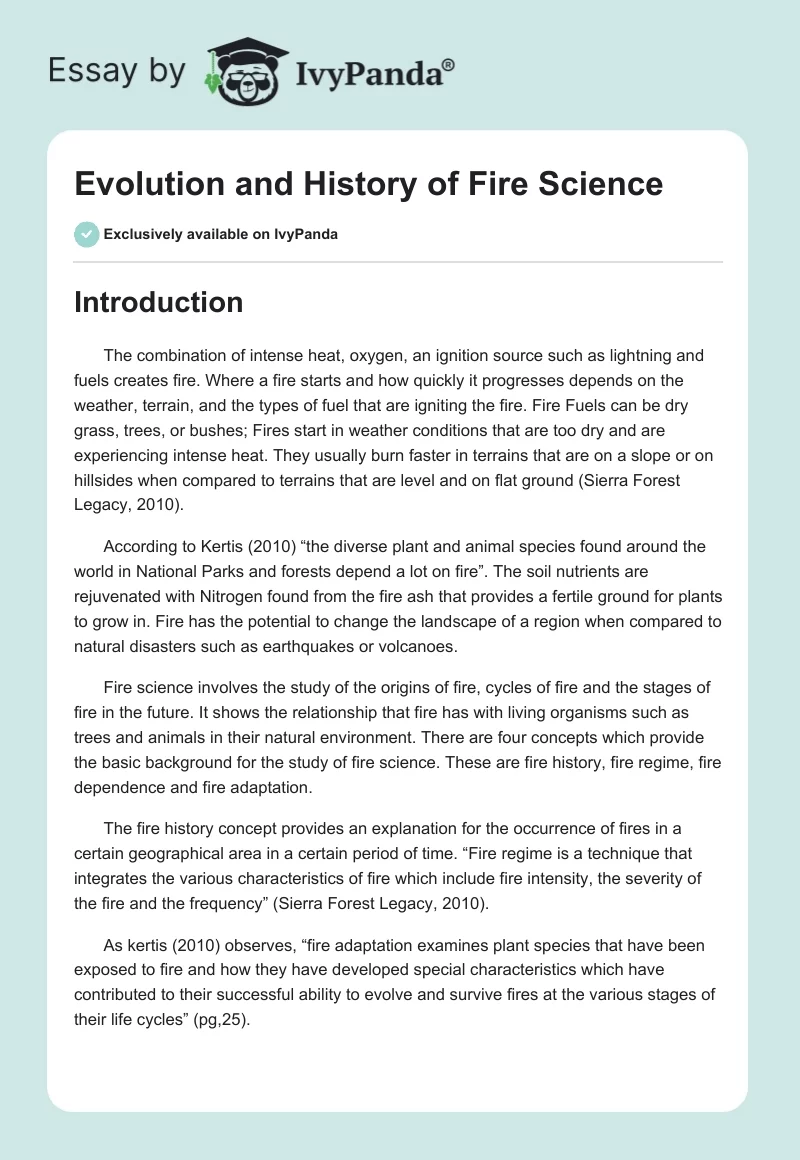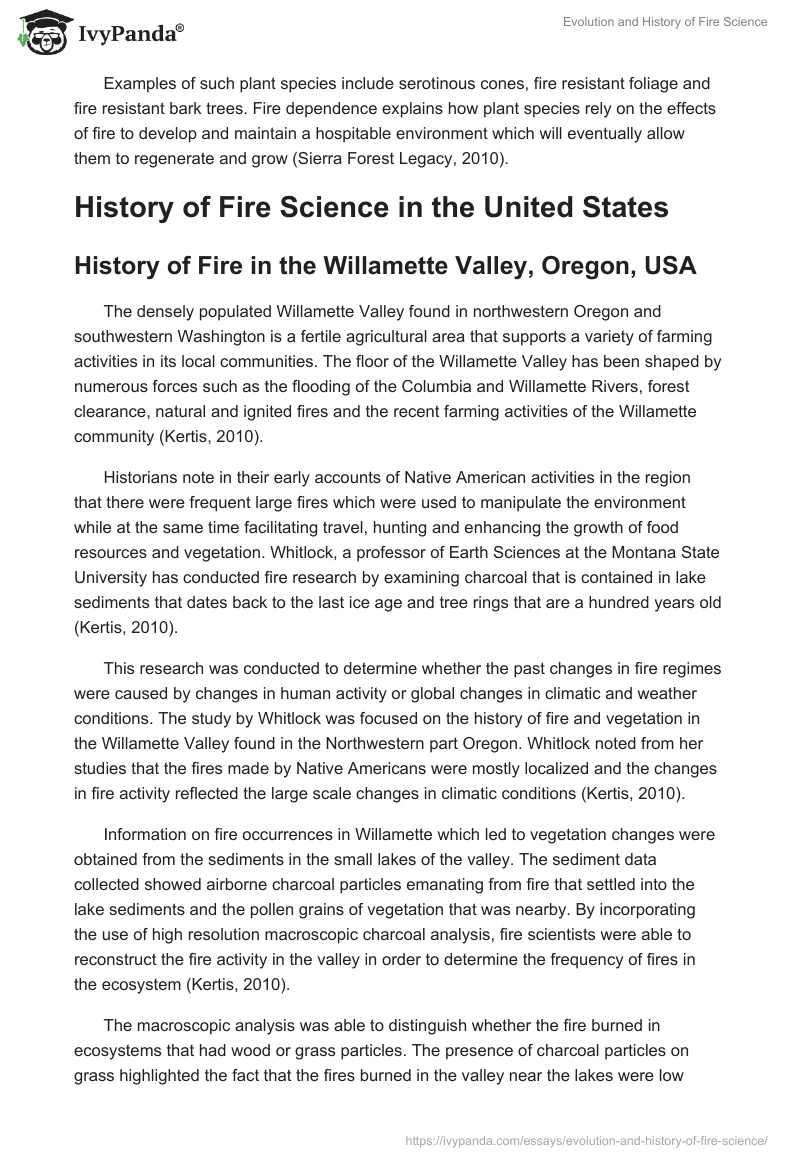Introduction
The combination of intense heat, oxygen, an ignition source such as lightning and fuels creates fire. Where a fire starts and how quickly it progresses depends on the weather, terrain, and the types of fuel that are igniting the fire. Fire Fuels can be dry grass, trees, or bushes; Fires start in weather conditions that are too dry and are experiencing intense heat. They usually burn faster in terrains that are on a slope or on hillsides when compared to terrains that are level and on flat ground (Sierra Forest Legacy, 2010).
According to Kertis (2010) “the diverse plant and animal species found around the world in National Parks and forests depend a lot on fire”. The soil nutrients are rejuvenated with Nitrogen found from the fire ash that provides a fertile ground for plants to grow in. Fire has the potential to change the landscape of a region when compared to natural disasters such as earthquakes or volcanoes.
Fire science involves the study of the origins of fire, cycles of fire and the stages of fire in the future. It shows the relationship that fire has with living organisms such as trees and animals in their natural environment. There are four concepts which provide the basic background for the study of fire science. These are fire history, fire regime, fire dependence and fire adaptation.
The fire history concept provides an explanation for the occurrence of fires in a certain geographical area in a certain period of time. “Fire regime is a technique that integrates the various characteristics of fire which include fire intensity, the severity of the fire and the frequency” (Sierra Forest Legacy, 2010).
As kertis (2010) observes, “fire adaptation examines plant species that have been exposed to fire and how they have developed special characteristics which have contributed to their successful ability to evolve and survive fires at the various stages of their life cycles” (pg,25).
Examples of such plant species include serotinous cones, fire resistant foliage and fire resistant bark trees. Fire dependence explains how plant species rely on the effects of fire to develop and maintain a hospitable environment which will eventually allow them to regenerate and grow (Sierra Forest Legacy, 2010).
History of Fire Science in the United States
History of Fire in the Willamette Valley, Oregon, USA
The densely populated Willamette Valley found in northwestern Oregon and southwestern Washington is a fertile agricultural area that supports a variety of farming activities in its local communities. The floor of the Willamette Valley has been shaped by numerous forces such as the flooding of the Columbia and Willamette Rivers, forest clearance, natural and ignited fires and the recent farming activities of the Willamette community (Kertis, 2010).
Historians note in their early accounts of Native American activities in the region that there were frequent large fires which were used to manipulate the environment while at the same time facilitating travel, hunting and enhancing the growth of food resources and vegetation. Whitlock, a professor of Earth Sciences at the Montana State University has conducted fire research by examining charcoal that is contained in lake sediments that dates back to the last ice age and tree rings that are a hundred years old (Kertis, 2010).
This research was conducted to determine whether the past changes in fire regimes were caused by changes in human activity or global changes in climatic and weather conditions. The study by Whitlock was focused on the history of fire and vegetation in the Willamette Valley found in the Northwestern part Oregon. Whitlock noted from her studies that the fires made by Native Americans were mostly localized and the changes in fire activity reflected the large scale changes in climatic conditions (Kertis, 2010).
Information on fire occurrences in Willamette which led to vegetation changes were obtained from the sediments in the small lakes of the valley. The sediment data collected showed airborne charcoal particles emanating from fire that settled into the lake sediments and the pollen grains of vegetation that was nearby. By incorporating the use of high resolution macroscopic charcoal analysis, fire scientists were able to reconstruct the fire activity in the valley in order to determine the frequency of fires in the ecosystem (Kertis, 2010).
The macroscopic analysis was able to distinguish whether the fire burned in ecosystems that had wood or grass particles. The presence of charcoal particles on grass highlighted the fact that the fires burned in the valley near the lakes were low severity surface fires. The presence of charcoal particles on wood indicated that the intensity of the fire was highly severe.
Kertis noted from tree ring studies that there was a dramatic change from extensive local burning to small burning or fires in recent times. Together with Heyerdahl, a research forester, Kertis examined the stumps of harvested trees in the upland area of the valley floor to gain baseline information about the history of fire.
They used the tree stumps because most of the old trees were logged and cleared for agriculture. Their examinations showed the severity of fire which varied from low severity to mixed low- high severity and high severity. They however could not provide evidence as to whether the fires were ignited naturally or by humans.
History of Fire and Climate Influences in Sierra Nevada, USA
According to Moody et al. (2006), dendrochronology, which is the study of tree rings, shows that the investigations on fire history have shed light on the patterns of fire for a given location by providing the evidence for the fire’s historical and pre-settlement role in the ecosystem of these locations.
Studies conducted by Skinner and Chang in 1996 showed there were moderate fires in the mid-elevation forests of Sierra Nevada which burned many times in a century. These fires were low in intensity and they often burned for months and at times covering large areas.
Research efforts have been aimed at establishing the pre-settlement conditions of Native Americans in the late 19th century and the early 20th century. These studies have also focused on the structure of the forest and the process changes that were caused by the disruption of pre-settlement fire regimes during the same period. The fire regimes were influenced by factors such as fuels, vegetation types, weather and the ignition sources; whether they are natural or anthropogenic (Moody et al, 2006).
Recent research conducted by various researchers such as Swetnam and Betancourt (1990, as cited by Moody et al, 2006) in the southwest and northwest areas of the United States have however shown the temporal patterns of fire to be connected to the inter-annual climate variables such as drought and the inter-decadal climate patterns such as the El Nino- Southern Oscillation (ENSO).
ENSO is an atmospheric process that is related to the variations in the sea surface temperature. These atmospheric processes fluctuate between warm and cool phases on time scales that are approximated to be three to six years and they are viewed to be the main influencer of inter-annual climate (Moody et al, 2006, p.126).
Moody et al note that fire in the northern part of Sierra Nevada was influenced by climatic condition time scales that were inter-annual and inter-decadal. The strong relationship between these time scales and drought indices showed that the climatic conditions for a given year had a significant influence on fire.
Drought indices would correspond to highly favorable fire conditions that rely on fuels and weather. Conditions that favor fire such as low fuel moistures and high air temperatures were found in drought years known as PDSI-derived drought years (Moody et al, 2006, p.22).
Evolution of Fire and Fire Science
Fowler and Konopik (2007) look at the evolution of fire through cultural periods that took place in the United States one of which is the Native American period. The frequencies and intensity of the fires varied across the regions that were mostly inhabited by the Native Americans. According to Quinitere (1998), these regions experienced major transitions due to climate changes. Fire scientists analyzed the charcoal content in the soil which highlighted the increase in frequency of fire as a result of these transitions.
The early settlement period was highlighted by the evolution of fire by the European settlers who also incorporated the practices of the Native Americans when it came to fire and the landscape.
The Native Americans used fire for cooking, entertainment, hunting and producing forage for wild animals while the European settlers used low intensity fires to clear their landscapes for agricultural practices and to create room for the construction of houses and other structures. Their fires were concentrated in grassland, woodland and hilltop areas (Fowler & Konopik, 2007).
As Quinitere (1998) notes, the industrial revolution period saw the expansion of the population and settlers in America. The fires in this period were high in intensity when compared to the European low intensity fires. This was mainly due to the large amount of logging and burning of forests and woodland areas. The high intensity fires were also attributed to the initial use of steam power in industrial factories and the development of locomotives. To suppress these fires, the fire suppression movement was born in the late 1890s.
The main agenda of the movement was focused on fire control in response to the industrial period’s destruction on the environment. It created an era of fire prohibition which saw a shift in fire regimes that were marked by longer fire return intervals.
The exclusion of fires from the southern landscapes created changes in vegetation such as the regeneration of forests and the change in composition of the ecosystem. The fire suppression movement led to the fire management period that uses the concept of prescribed fire to restore and maintain healthy ecosystems that are deemed to be productive (Fowler & Konopik, 2007).
The Role of Fire and Fire Science
Fire has played an essential role in the ecosystem of plants and animal habitats. This role has been made possible through fire suppression techniques and management practices. “Helens in 1980 clearly demonstrate that plant and animal ecosystems have the capability to recover from devastating natural occurrences” (Sierra Forest Legacy, 2010).
Fire has also played an important role in the development of the flora and fauna that is found in the Western parts of United States. Whether these fires were naturally ignited or not, they served as a constant in the ecosystem process, influencing the vegetation patterns of plants and the distribution of wildlife in the western region (Moody et al, 2006).
In the case of Willamette Valley, fire science research has shown that fire has been part of the ecosystem for 14,000 years and to add on, fire science has helped in managing the ecosystems found in the valley.
Vegetation such as the oak savanna, the conifer forest and the riparian woodland can be able to tolerate a wide range of fire and climatic conditions that have high in temperatures. Also some of the plant species that have shown a high resilience to fire regimes can be used in restoration and re-forestation projects in the area (Kertis, 2010).
Conclusion
Any efforts or plans aimed at recreating or protecting ecosystems must include fire. As research has shown fire plays an important role in creating an ecosystem that can regenerate itself while at the same time creating plant species that can resist fire occurrences.
References
Fowler, C. & Konopik, E. (2007). The history of fire in the southern United States. Society for Human Ecology, Human Ecology Review, Vol.14, No.2. pp 165-176.
Kertis, J. (2010). Tracing the history of fire in the Willamette Valley. Web.
Moody, T. J., Kaufman, J. A., & Stephens, S. L. (2006). Fire history and climate influences from forests in the northern Sierra Nevada, USA. Fire Ecology Journal, Vol. 2, No. 1, pp 115-141.
Sierra Forest Legacy (2010). Fire science and research. Web.
Quinitere, J. G. (1998). Principles of fire behavior. New York: Delmar, Thomson Learning Inc.


